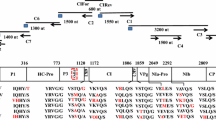Abstract
The complete genomic sequence of Celery mosaic virus (CeMV) was found to be 9999 nucleotides in length, excluding the 3′ poly(A) tail. The genome contains a single large open reading frame encoding a polyprotein of 3181 amino acids. Its genomic organization is typical of potyviruses and contains conserved motifs found in members of the genus Potyvirus. Pairwise comparison of the polyprotein sequences shows that CeMV shares 39.0-71.9% sequence identity with other members of the genus Potyvirus. Phylogenetic analysis based on the polyprotein sequences indicates that CeMV is most closely related to Apium virus Y, and together with Panax virus Y, the three viruses form a distinct clade.


Similar content being viewed by others
References
Adams MJ, Antoniw JF, Beaudoin F (2005) Overview and analysis of the polyprotein cleavage sites in the family Potyviridae. Mol Plant Pathol 6:471–487
Adams MJ, Antoniw JF, Fauquet CM (2005) Molecular criteria for genus and species discrimination within the family Potyviridae. Arch Virol 150:459–479
Alberts E, Francki RIB, Dietzgen RG (1989) An epidemic of Celery mosaic virus in South Australian celery. Aust J Agric Res 40:1027–1103
Bos L, Mandersloot HJ, Vader F, Steenbergen B (1989) An epidemic of celery mosaic potyvirus in celeriac (Apium graveolens var. rapaceum) in the Netherlands. Neth J P1ant Pathol 95:225–240
Chen J, Chen J, Adams MJ (2001) A universal PCR primer to detect members of the Potyviridae and its use to examine the taxonomic status of several members of the family. Arch Virol 146:757–766
Chung BY-W, Miller WA, Atkins JF, Firth AE (2008) An overlapping essential gene in the Potyviridae. Proc Natl Acad Sci USA 105:5897–5902
Kadaré G, Haenni AL (1997) Virus-encoded RNA helicases. J Virol 71:2583–2590
Koonin EV (1991) The phylogeny of RNA-dependent RNA polymerases of positive-strand RNA viruses. J Gen Virol 72:2197–2206
Latham LJ, Jones RAC (2004) Carrot virus Y: symptoms, losses, incidence, epidemiology and control. Virus Res 100:89–99
Li R, Mock R, Huang Q, Abad J, Hartung J, Kinard G (2008) A reliable and inexpensive method of nucleic acid extraction for the PCR-based detection of diverse plant pathogens. J Virol Methods 154:48–55
Lütcke HA, Chow KC, Mickel FS, Moss KA, Kern HF, Scheele GA (1987) Selection of AUG initiation codons differs in plants and animals. EMBO J 6:43–48
Moran J, Van Rijswijk B, Traicevski V, Kitajima EW, Mackenzie AM, Gibbs AJ (2002) Potyviruses, novel and known, in cultivated and wild species of the family Apiaceae in Australia. Arch Virol 147:1855–1867
Pemberton AW, Frost RR (1974) Celery mosaic virus in England. Plant Pathol 23:20–24
Severin HHP, Freitag JH (1935) California celery mosaic disease. Phytopathology 25:891
Severin HHP, Freitag JH (1938) Western celery mosaic. Hilgardia 11:493–558
Shepard JF, Grogan RG (1967) Partial purification, properties and serology of Western celery mosaic virus. Plant Dis Reptr 57:1104–1110
Sutabutra T, Campbell RN (1971) Strains of celery mosaic virus from parsley and poison hemlock in California. Plant Dis Reptr 55:328–332
Tamura K, Dudley J, Nei M, Kumar S (2007) MEGA4: Molecular Evolutionary Genetics Analysis (MEGA) software version 4.0. Mol Biol Evol 24:1596–1599
Urcuqui-Inchima S, Haenni AL, Bernardi F (2001) Potyvirus proteins: a wealth of functions. Virus Res 74:157–175
Xu DL, Zhou GH, Xie YJ, Mock R, Li R (2010) Complete nucleotide sequence and taxonomy of Sugarcane streak mosaic virus, member of a novel genus in the family Potyviridae. Virus Genes 40:432–439
Xu DL, Liu HY, Koike ST, Li F, Li R (2010) Biological characterization and complete genomic sequence of Apium virus Y infecting celery. Virus Res. doi:10.1016/j.virusres.2010.09.002
Yan ZL, Song LM, Zhou T, Zhang YJ, Li MF, Li HF, Fan ZF (2010) Identification and molecular characterization of a new potyvirus from Panax notoginseng. Arch Virol 155:949–957
Acknowledgements
We thank Dr. Bryce Falk for providing the celery mosaic virus isolate and John Sears for excellent technical assistance.
Author information
Authors and Affiliations
Corresponding author
Rights and permissions
About this article
Cite this article
Xu, D., Liu, HY., Li, F. et al. Complete genome sequence of Celery mosaic virus and its relationship to other members of the genus Potyvirus . Arch Virol 156, 917–920 (2011). https://doi.org/10.1007/s00705-011-0951-x
Received:
Accepted:
Published:
Issue Date:
DOI: https://doi.org/10.1007/s00705-011-0951-x




